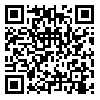BibTeX | RIS | EndNote | Medlars | ProCite | Reference Manager | RefWorks
Send citation to:
URL: http://jdisabilstud.org/article-1-2871-en.html
2- Professor of Clinical Psychology, School of Medicine, Children and Adolescents Health Research Center, Research Institute of Cellular and Molecular Sciences in Infectious Diseases, Zahedan University of Medical Sciences, Zahedan, Iran
3- Assistant Professor, Department of Psychology, Zahedan Branch, Islamic Azad University, Zahedan, Iran
Abstract
Background & Objectives: Mental disorders have symptoms characterized by disorders in a person's cognition, emotion regulation, or behavior. The disorders reflect distortions in the psychological, biological, or developmental processes underlying mental functioning. Mental disorders are usually associated with significant discomfort or disability in social, occupational, or other vital activities. The Rorschach test is a well–known and widely used projection test for the diagnosis of various psychiatric disorders. Based on perception and projection, Rorschach spots put the subjects in a position where they must organize their reactions to the spots without the examiner's guidance. The test situation is such that they can freely enter what they want in this experience and throw their needs, feelings, experiences, and tensions, mainly in the unconscious level of the mind, into the stains. The present study aims to compare the responses of patients with mental disorders and people without mental disorders in the indicators of the Rorschach test based on Exner's comprehensive system.
Methods: The research method was causal–comparative. The statistical population of the clinical group included all patients with psychological disorders who were referred to the treatment centers of Zahedan City, Iran, in 2020. Among them, 80 male and female patients (20 schizophrenics, 20 anxiety disorders, 20 depressive disorders, 20 personality disorders) who were diagnosed with these disorders with the approval of a psychiatrist and clinical psychologist were chosen by purposive sampling. The sample of people without mental disorders comprised 100 healthy people from the general population who were willing to participate in the Rorschach test with their consent. They were selected by available sampling. Then, the Rorschach test was administered individually and scored according to Exner's comprehensive system. The data were analyzed using statistical methods of frequency, mean, standard deviation, and the independent two–group t test in SPSS 23. The significance level of all tests was considered 0.05. Also, the present study was approved by the Ethics Committee of Zahedan University of Medical Sciences and registered under the number IR.ZAUMS.REC.1400.018.
Results: The results showed significant differences (p<0.05) between people with mental disorders and those without mental disorders in the indicators of developmental quality (DQv, FQx–, FQxNone, MO), composite scores (AdjD, 2AB+(Art+Ay), X–%, XA%), specific scores (DR1, X–%, MOR, PHR, AG, PER, DR2, Wsum6, PSV, COP, AdjD), common answers (p), some content indicators (A, BI, [A] Ay), determinants (Cn, FD, CF, C, C'F, TF, YF, Y, F), and special index variable (PTI, DEPI, S–CON).
Conclusion: The results of this research confirmed the difference in the responses of people with psychological disorders compared to people without psychological disorders. It also showed that the Rorschach test can be used as an effective tool in identifying and diagnosing mental disorders. Also, given the importance of mental disorders and their effects on mental health, the use of psychological tests can practically help clinical psychologists and psychiatrists by providing low–cost evaluation for early diagnosis of psychological disorders.
| Rights and permissions | |
 |
This work is licensed under a Creative Commons Attribution-NonCommercial 4.0 International License. |




